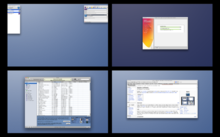Spaces (software)
 |
|

A screenshot of Spaces on Mac OS X 10.5 Leopard
|
|
| Developer(s) | Apple Inc. |
|---|---|
| Stable release |
1.1 / August 28, 2009
|
| Development status | Discontinued |
| Operating system | Mac OS X |
| Type | Virtual desktop |
| License | Proprietary |
| Website | http://www.apple.com/.../spaces.html |
Spaces was a virtual desktop feature of Mac OS X, introduced in Mac OS X 10.5 Leopard. It was announced by Steve Jobs during the opening keynote at the Worldwide Developers Conference on August 7, 2006. As of Mac OS X 10.7 Lion, it has been incorporated into Mission Control.
Spaces enables users to create multiple virtual desktops suited to the unique needs or work habits of the user. A user could, for example, create and assign a "space" to office work, enabling him or her to leave a work-related application (such as a word processor or a spreadsheet) running full screen and then switch to a different space designated for browsing the Internet or navigating file structure in Finder windows. Up to 16 spaces can be created, and applications can be bound to specific spaces. There are various ways to navigate between spaces, including user-configured, function-key combinations, hot corners (via Exposé), or by dragging windows and applications — in the direction of the desired space — to the corresponding edge of the screen and holding for a moment until the space switches. The Dashboard functions as a separate space, on the left of the other spaces by default.
In Mac OS X 10.5 Leopard System Preferences, a checkbox labeled "Enable Spaces" must first be checked in the "Exposé & Spaces" preferences, under the "Spaces" tab. Then, as many as 16 spaces can be created by adding rows or columns. Application assignments may be added and bound to specific spaces listed, by their corresponding numbers, in the right-hand column. When an assigned application is launched, it will open on the designated space and remain in that location unless it is moved manually to another space.
...
Wikipedia
